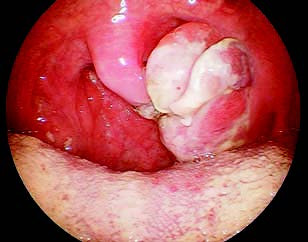Malignant tumors of the tonsils are common malignant neoplasms of the oropharynx. The etiology is often associated with excessive smoking and alcohol consumption, HPV infection, and environmental pollution. Cases related to HPV infection generally have a better prognosis compared to non-HPV-related cases.
Pathology
Tonsillar carcinoma, including squamous cell carcinoma, lymphoepithelial carcinoma, undifferentiated carcinoma, and adenocarcinoma, has the highest incidence. Lymphoma ranks second, while other types of malignant tumors, such as sarcoma, malignant hemangioendothelioma, and melanoma, are rarer.
Clinical Manifestations
Early-stage symptoms include discomfort in the throat, a foreign body sensation, unilateral throat pain, and worsening pain during swallowing. Some patients may present with a neck mass prior to observable signs in the pharynx. In advanced stages, throat pain becomes more severe and may lead to ipsilateral referred ear pain, dysphagia, slurred speech, and trismus. In rare cases, lymphoma may involve bilateral tonsils.
Examinations
The affected tonsil is significantly enlarged with an irregular surface, ulceration, nodular elevation, hardness upon palpation, and a tendency to bleed easily. Adhesion to surrounding tissues may also be observed. Ipsilateral cervical lymph nodes may be palpated as enlarged, hard, fixed, and non-tender masses. Imaging modalities such as CT, MRI, PET-CT, and ultrasound are useful for assessing the tumor's extent, as well as local and distant metastases.

Figure 1 Left-sided tonsillar carcinoma
Diagnosis
In adults, a unilateral tonsil that is significantly enlarged, ulcerated, hard, and immobile, along with ipsilateral submandibular lymphadenopathy, enables a relatively straightforward diagnosis. However, cases with bilateral tonsillar enlargement, congestion, and a smooth surface may easily be misdiagnosed as acute tonsillitis, which requires careful consideration. Pathological diagnosis remains the gold standard. If the tumor is squamous cell carcinoma, HPV-related tests should also be conducted to determine the clinical stage of the tumor.
Treatment
Treatment strategies vary based on the pathological type and clinical stage of the tonsillar tumor. In cases of tonsillar squamous cell carcinoma, comprehensive treatment may involve radiotherapy, chemotherapy, targeted therapy, immunotherapy, and surgical intervention of varying intensity, depending on the HPV-related test results.
Surgical approaches may include transoral or extended resection after mandibulotomy, along with neck dissection. Adjuvant treatment is often performed preoperatively or postoperatively. For some sarcomas and lymphomas that are sensitive to radiation, comprehensive treatment comprising radiotherapy, chemotherapy, and immunotherapy is recommended.